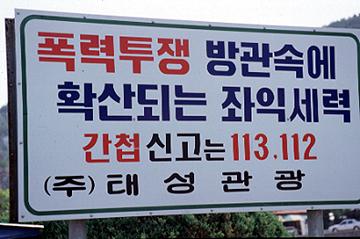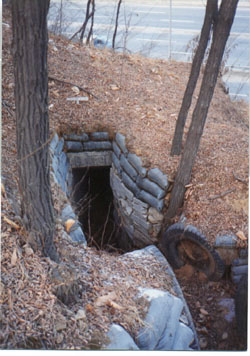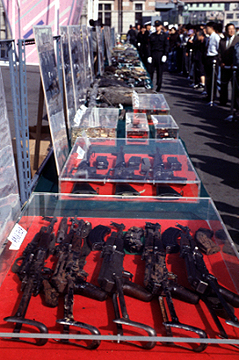
Divided Korea
 |
One thing the traveller to Korea will notice almost immediately is the evident importance of national defense in this divided nation. Signs just like this one are present all over South Korea, giving various warnings to the population about the threat from North Korea. The rhetoric of this particular sign alludes to the threat posed by those who demonstrate opposition to the southern government. Translated, it reads: If you just stand by and let violent demonstrations happen, then leftists will take over. If you have information on infiltrators or informants call 112 or 113. |
| Infantry trenches and revetments like this one in Kupabal are commonly seen all over Korea, especially north of Seoul. | 
|
 |
..this is the entrance to a reinforced machinegun nest that overlooks a road in Kupabal. |
| Infiltrators (from North Korea) actually are a reality in South Korea. This map was part of a government exhibition at Seoul Station where the contents of the North Korean submarine that landed near Kangnung on the east coast in September, 1996 were displayed. The map shows a section of the east coast where the sub landed, and shows red dots where the South Korean Army killed infiltrators as they tried to flee back into the North when their mission failed. | 
|
 |
These AK-47s were supposedly found in the submarine, as well as other weapons, radios, cameras, southern military and civilian clothing, code books, etc. |
| This is part of the 'security system' that protects sections of the east coast of South Korea. If infiltrators from the sea try to pass the barbed wire, they will knock down the stack of painted rocks. Soldiers passing by will see that the stones have fallen over, and the hunt will be on! It only goes to show that closely observing and defending hundreds of miles of coastline is next to impossible. | 
|
 |
This map shows the border between the North and South, with the 'Joint Security Area' in raised detail. The JSA is the only place where government contacts between North and South are held on the penninsula. It's situated inside the DMZ. It is also a meeting place where the opposing sides' militaries maintain the armistice that has held since July, 1953. (No peace treaty was signed ending the war.) |
| The blue-painted bridge on the left is the only link to the JSA, and is called 'freedom bridge'. The wooden bridge in the middle is where POWs were allowed to cross back into the South at the end of the war. In the foreground is a memorial place for southern families who have relatives in the North. This is the furthest north that they can travel. | 
|